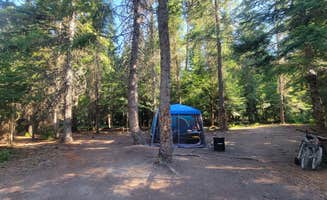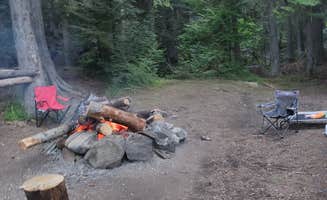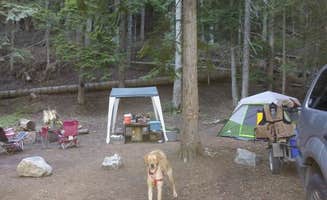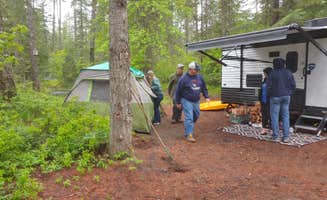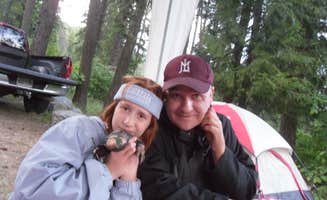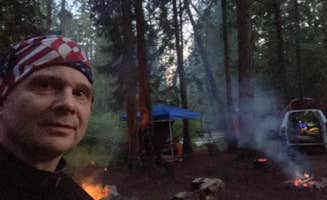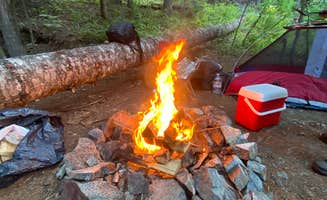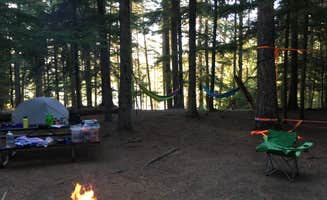Camping near Usk, Washington occurs at elevations between 2,000-2,500 feet, creating relatively cool evenings even during summer months. The region sits within the Colville National Forest with campgrounds scattered around several small lakes and creek systems. Most dispersed camping areas require travel on Forest Service roads that become increasingly primitive the further from Highway 20 you venture.
What to do
Fly fishing opportunities: Browns Lake Campground offers a dedicated fly-fishing-only lake with favorable conditions for beginners and experienced anglers. "Great little lake to get away to and camp. Fly fishing only, quiet and great for kayaking. Nice trail along lake to a grove of old growth trees," reports one visitor to Browns Lake Campground.
Hiking trails: A mile-long loop trail circles South Skookum Lake providing access to wildlife viewing areas. "The lake loop takes about 45 minutes to complete," according to a camper at South Skookum Lake Campground. Another visitor noted, "There is a nice trail that goes around the lake where you will see a variety of wildlife."
Swimming access: During summer months, water temperatures at Cooks Lake reach comfortable levels for swimming. "The water was warm and we swam all day. Bats at night, and the stars!!" shared one camper. The beach areas tend to be narrow with a mix of dirt and rock shorelines rather than sand.
What campers like
Campsite privacy: Many campsites offer substantial separation between sites with natural barriers. At Skookum Creek Campground, a visitor observed that "each site has loads of elbow room" and another noted "nice spots spaced quite far apart." This privacy extends to most of the established campgrounds in the region.
Night sky viewing: The remote location creates excellent stargazing conditions with minimal light pollution. One camper at Cooks Lake described their experience: "The early mornings on the lake were worth it. The mist rising and the vast, green mountains, right in front of you! Birds everywhere, woodpeckers in the birch trees and killdeer darting down to the water."
Clean facilities: Despite their remote locations, many campgrounds maintain well-kept vault toilets. At Pioneer Park, "Bathrooms were very clean and drinking water is available," according to one visitor, while another noted that "several vault toilets on site were very clean."
What you should know
Road conditions: Access to many campgrounds requires travel on increasingly primitive roads. A visitor to Cee Cee Ah Creek mentioned, "Nearby campsites are far enough away that you have plenty of privacy," but getting there requires navigating forest service roads. Another camper described their journey to Cooks Lake: "The road to get there was approx six miles of gravel winding single lane road. But so worth the drive."
Bear country precautions: All camping areas in this region require proper food storage. "It is bear county so be sure to bring bear proof containers although it was so hot when we went that the wildlife was hiding out," advised one Cooks Lake visitor. Most established campgrounds have bear-resistant trash receptacles.
Limited cell service: Connectivity drops significantly at most camping areas around Usk. One visitor to Browns Lake mentioned the need to bring all supplies since there's "no water, so bring your own" and no cell service to coordinate last-minute needs. Plan accordingly with offline maps and emergency communication alternatives.
Tips for camping with families
Playground access: Families with younger children may prefer Thousand Trails Little Diamond where "if you are camping with kids the spots closer to the playground equipment are perfect," according to one visitor. Another noted, "The campground has daily activities if you want to keep busy or keep the kids busy."
Swimming safety: Lake shorelines in the area typically have gradual entry points but rocky bottoms. At Pioneer Park, one visitor mentioned, "The beach is good but not great," indicating families should bring water shoes. Most lakes in the area have no lifeguards.
Wildlife viewing opportunities: Morning and evening hours offer the best wildlife spotting chances. One camper at Pioneer Park reported "Mama deer and two fawns visited our site. River is nearby with a rocky beach but nice. We even saw a bald eagle."
Tips from RVers
Site size limitations: Most forest service campgrounds accommodate smaller RVs but have tight access roads. A visitor to Pioneer Park noted their experience: "Sites large enough to accommodate our 31 foot Toy Hauler," while another camper mentioned, "less than a dozen sites for bigger rigs. Not all sites are level."
Hookup availability: Full hookups are limited to private RV parks like Eagles Landing RV Resort. "Hookups are on the wrong side at most of the sites," reported one RVer at Eagles Landing. Plan for dry camping at most forest service locations.
Leveling requirements: Prepare with leveling blocks as most natural sites have some slope. At Browns Lake Campground, the sites are described as "generous sized" but visitors should note that forest service campgrounds typically don't offer the graded pads found at private resorts.


